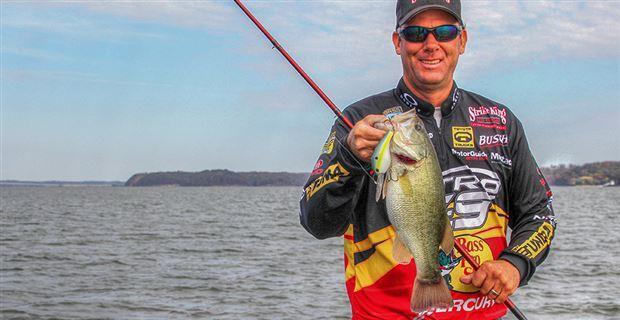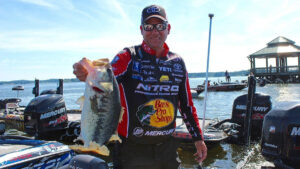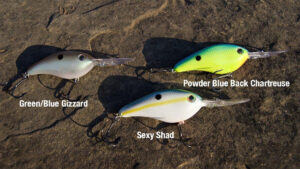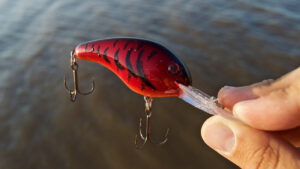Deep-diving crankbaits become a go-to lure for many bass anglers as the fish finish spawning and head out to their deeper haunts. Crankbaits running from 12 to 20-plus feet offer fisherman the opportunity to cover offshore structure quickly and efficiently. Hardly anyone could attest to the effectiveness of these lures better than the most decorated man in competitive bass fishing, Kevin VanDam.
Dredging the bottom with deep crankbaits has accounted for a pile of KVD’s tournament victories and a large sum of his over $6 million in career earnings. While he may use a myriad of different colors throughout a fishing season, there are 5 tried and true deep-diving crankbait color patterns VanDam trusts most.
Deciding factors
Before VanDam makes a single cast on a fishery, there are three key factors he clues in on to help decide what color patterns he will employ.
“As soon as I pull up to a lake, my brain starts taking in the current conditions,” VanDam said. “The water clarity and sky conditions are the first things I notice that’ll help me get a feel for which colors I need to use. Lastly I’ll use the forage base, or whatever I think the bass are feeding on at that time, to help make my decision.”
Water clarity
Water clarity is the easiest detail to notice when it comes to deciding what color(s) to use, but its also the most important. It’s not as simple as “clear” or “dirty”’ to KVD, however.
Generally the lakes he fishes have a fair amount of color to the water, and VanDam makes sure to pinpoint the fine details.
Is the water stained? Does it have a green or a brown hue to it? Are there different mud lines throughout the fishery? Is it constant throughout the entire water column? All of these details are important to VanDam and help him make a decision of which crankbait to reach for.
Sky conditions (light penetration)
The current sky conditions and the light penetration these conditions allow is another factor VanDam believes heavily influences what color a bass is likely to eat. This changes day-by-day and even hour-by-hour on a fishery.
“Light penetration changes by the minute,” VanDam said. “By sky conditions, I mean more than just is it cloudy or sunny. I factor in the light penetration allowed first thing in the morning and how that is going to change throughout the day. From there, I consider how cloud cover or weather systems moving through the area will affect the baitfish and the bass.”
Forage
The third factor VanDam takes in to consideration when choosing crankbait color is the primary forage base on which the bass are focusing. VanDam knows forage base is important, but not necessarily critical, as bass are opportunistic creatures and will feed on multiple forage types throughout the year.
VanDam does his research so he knows what type of prey items are available to bass in a particular fishery and from there, makes his best guess at what they are primarily eating.
The specific color patterns VanDam is referring to, and the corresponding photos, are KVD’s namesake Strike King XD series. Though Strike King crankbaits work best for VanDam, nearly every hard bait company in the bass fishing industry offers a color pattern similar to VanDam’s 5 favorites. They all work, especially when they are employed under reciprocal conditions.
KVD’s all-time favorite: Sexy Shad
The first three patterns are colors VanDam relies on if he believes bass are predominantly feeding on shad or some type of baitfish. The first being Sexy Shad, a color that KVD single handedly made famous in the past two decades.
“Sexy Shad is no doubt my all-time favorite color,” VanDam said. “It simply is a great shad-imitating color pattern, which is standard forage most anywhere I fish, and has worked for me in a variety of scenarios and conditions. Sexy Shad is equally as good under low-light conditions as it is when the sun is real high in the afternoon. I have more confidence in Sexy Shad than any other color when I know bass are keying in shad, bar none. ”
While he has successfully used sexy shad in a variety of scenarios, VanDam says it’s best in slightly stained water.
Powder Blue Back Chartreuse
“If I’m faced with murky to muddy water and bass are eating shad, the powder blue back chartreuse is my first choice,” VanDam said. “It’s a real bright color that has a glow to it in dirty water scenarios, especially if there is a brown tint to the water. In lowlight conditions, which are what you have in heavily stained deep water, I believe bass see in black and white. If you take a black and white photo of a powder blue back crankbait it’ll look like it glows white, which helps the bass see the bait in that deeper zone.”
Green/Blue Gizzard Shad
If VanDam is fishing a lake with 2 1/2 feet or more of visibility and bass are keying in on baitfish, then a variation of Blue Gizzard shad or Green Gizzard shad gets the nod.
“The clearer the water, the more important the details become when you’re talking about color,” VanDam explained. “I vary between green and blue gizzard colors based on the color of the forage. If bass are feeding on baitfish like alewives or blue back herring then I’ll go with blue gizzard. If the baitfish have a green tinge to them I’ll go with the green gizzard color. Both options have a much more natural look to them and aren’t as loud of a shad pattern as Sexy Shad.”
Crawfish pattern
Although VanDam says they are predominantly for the spring months, he was sure to include a red crawfish color pattern like Delta Craw or Chili Craw to his list.
“If I’m using a deep diving crankbait during the pre-spawn it’s almost always a red craw color,” VanDam said. “When the water is muddy from spring rains during the prespawn period crayfish are king, and for me it’s hard to beat a red craw pattern. There are certain lakes like Table Rock or the California Delta where these colors work all year long, but it’s predominately a spring deal. Still, if I could only pick 5 colors, a red craw would definitely be in the mix.”
Barfish
VanDam’s most recent addition to his favorites list is Barfish. Barfish is meant to imitate the often-overlooked forage species of yellow bass, white bass and crappie.
“If I’m on a fishery with big largemouth and I think they are eating yellow or white bass, Barfish is a terrific option,” VanDam said. “It’s a very natural looking color in the water and perfectly mimics yellow bass, white bass, crappie or even crappie; which big bass love to feed on. A 6XD and 10XD in Barfish helped me get the win last year at the Elite Series event on Toledo Bend Reservoir. Since then, it’s been one of my favorites.”
Whether you are a novice to deep crankbait fishing or if you’re simply looking to add a few proven colors to your crankbait box this summer, VanDam’s 5 favorite colors are an excellent place to start. Use VanDam’s deciding factors and apply them to the fisheries in your area to help you determine the best color for the given conditions. Bass are moving offshore all around the country and it’s time to get cranking.
















